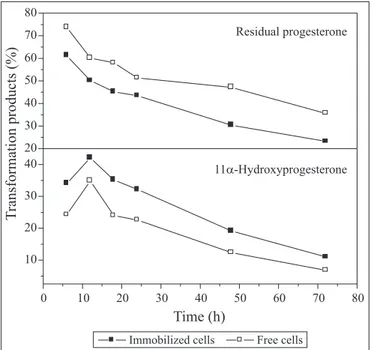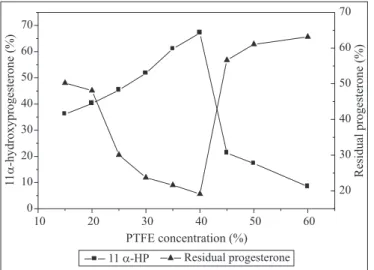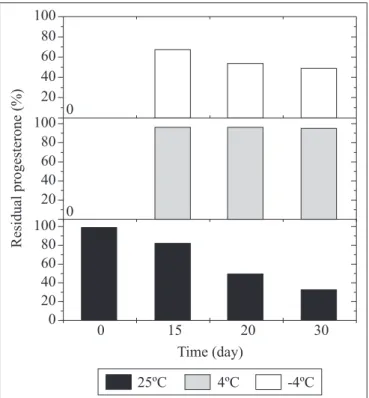PRODUCTION OF 11
α
α
α
α
α
-HYDROXYPROGESTERONE USING
ASPERGILLUS TERREUS
IMMOBILIZED ON POLYTETRAFLUOROETHYLENE
E.M. Ahmed
Natural and Microbial Products Chemistry Dept., National Research Center, Dokki, Cairo, Egypt
Submitted: July 07, 2006; Returned to authors for corrections: September 04, 2006 Approved: February 12, 2007.
ABSTRACT
In attempt to immobilize the mycelial fungi on a new hydrophobic matrix,
Aspergillus terreus
mycelia were
immobilized into polytetrafluoroethylen (PTFE) and used for selected conversion of progesterone to 11
α
-hydroxyprogesterone. The immobilized cells exhibited higher yields than the free cells. Different parameters
that can affect the cell activity were measured. The optimum pH was 6 and the optimum temperature was 30ºC.
Higher transformation activities were achieved with matrix contained 40% PTFE. No considerable loss in yield
was observed with storage of the cells at 4ºC for 30 days. Utilization of the immobilized cells in repeated batch
processes indicated that the cells retained about 84% of their activity after reuse for eight successive cycles.
Key words: 11α-hydroxprogesterone, polytetrafluoroethylene, Aspergillus terreus
INTRODUCTION
Immobilization of microorganisms for biotransformation of
steroids received increasing attention over the last several years
(3,7,11,15,20,22). However, immobilization of fungal mycelia is
difficult and often results in subsequent loss of many metabolic
activities due to damage of the cells. Consequently, retention of
the cells activities after immobilization is critical for the success
of the immobilization process (12). Generally, there are few
detailed and comprehensive studies on immobilization. Selection
of the support material and the method of immobilization is made
by measuring the properties and limitations characteristics of
support materials and immobilization techniques. The main
shortcomings of isotropic xerogel carriers are low durability and
the mass transfer problem (14,17,28). One of the feasible
approaches for reduction of mass transfer resistance to diffusion
of the substrate materials is to immobilize the cells into a thin
film or on the surface of a membrane (2,10). Another possibility
is to immobilize the cells in a fibrous matrix, attained by natural
attachment or crosslinking to the fibers (10).
Immobilization of cells within a hydrogel creates significant
mass transfer resistance e.g. hindrance of substrate diffusion
into/out the immobilized cells (26).
*Corresponding Author. Mailing address: Natural and Microbial Products Chemistry Dept., National Research Center, Dokki, Cairo, Egypt. E-mail: eahmed1998@yahoo.com
The use of hydrophobic immobilization matrices especially
for biotransformation of hydrophobic substrates may allow for
more favorable diffusion conditions (30). The operational and
diffusion conditions should be carefully optimized since high
stirring speeds or liquid phase flow rates can cause the rupture
the immobilization matrix (9).
reduce undesired voids. The conditions of paste formation
play a crucial role since the liquid distribution within the paste
depends on these conditions (5). Operational conditions such
as selecting level and duration of applied pressure ensure
that even liquid distribution inside the paste is attained. This
helps in obtaining PTFE with acceptable mechanical properties
(1,19).
This investigation aimed at the utilization of PTFE as a new
compatible carrier for filamentous fungi. The scope of the work
was to investigate the ability of the cells to withstand the harsh
immobilization process and to evaluate the potency of the
immobilized cells to withstand different stresses of a
transformation process. Transformation of poorly soluble
progesterone into 11
α
-hydroxyprogesterone (11
α
-HP) was
selected as an ideal transformation process. Importance of 11
α
-HP as anti-inflammatory agent and in synthesis of cortisone is
well known (23,29,31). Specific characteristics of the immobilized
cells such as the ability to ensure long term repeated batch
processing, stability to stirring conditions, substrate
concentrations and pH and temperature variation were targeted.
During the experiments the biochemical characteristics of the
immobilized cells were determined on the basis of conversion
of progesterone. To best of our knowledge this is the first time
for PTFE, to be used as a carrier for filamentous fungus.
MATERIALS AND METHODS
Chemicals: chemicals used in this work were purchased from
Sigma Chemicals Co., St. Louis, MO and Fluka. The organic
solvents were AR grade.
Microorganisms: the
Aspergillus terreus
strain was obtained
from Natural and Microbial Products Chemistry Department.,
National Research Center, Cairo, Egypt. The fungus was
maintained on slants containing medium composed of infused
white potato 300, Glucose 20 and agar 20 (g/l) at 4ºC. The slants
were subcultured monthly.
Medium and culture conditions: the inoculum was transferred
from slants to Erlenmeyer flasks (250 ml) containing 50 ml sterile
medium composed of (g/l): Sucrose 20, NaNO
32, KH
2PO
41.0,
KCl 0.5, Mg
2SO
4.7H
2O 0.5, FeSO
4.7H
2O 0.005. The pH of the
medium was adjusted to 5.6 and the spore concentration was
3x10
6/ml. The flasks were incubated on rotatory shaker at 27ºC
and 150 rpm for 48 h.
Immobilization technique: the mycelial cells in the medium
were harvested by filtration and washed with saline solution. A
slurry of PTFE particles (0.05-0.5 µm) in emulsion (approx. 60%
by weight) was added dropwise to the cells suspension to a
final concentration of 30% (w/w). The formed mixture was then
centrifuged at 4000 rpm for 15 min. The supernatant was removed
and the mixture was washed with phosphate buffer and
centrifuged again. The mixture was placed in Petri dish and
pressed carefully with a rubber mill in different directions to
form a thick membrane of approximately 3 mm thickness. The
resulting membrane was cut into pieces.
Biotransformation technique: the membrane pieces
containing the immobilized cells were suspended in 250 ml
Erlenmeyer flasks containing 50 ml of the same medium prepared
for growing the cells. The pH of the medium was adjusted to
5.6. Ten mg of progesterone dissolved in appropriate amount of
absolute alcohol were added to each flask. The flasks were
incubated on rotary shaker at 27ºC and 150 rpm. After the
specified transformation period, the content of each flask was
extracted three times with equal volume of chloroform. The
extracts were combined and washed with sodium bicarbonate
(2%), dried over anhydrous sodium sulfate and evaporated to
form the test material (8,18).
Qualitative analysis: the test materials were dissolved in
chloroform:methanol (1:1 v/v). The transformation products in
the test material were detected by TLC using silica gel G60 (18).
Cyclohexane:chloroform:isopropanol (10:5:2) was used as
developing solvent system. The transformation products were
identified after comparison with a standard product.
Quantitative analysis: the transformation products (11
α
-HP
and progesterone) in 1 ml of sample (test materials) were assayed
spectrophotometrically (8,18), and the results were confirmed
using HPLC (HP, Agilent series 1100, USA). HPLC analysis was
performed under the following conditions: Hi Plex Pb column
(Schimadzu, PL, USA), detection at 254 nm, flow rate 1 ml/min
and methanol:water (70:30 v/v) as solvent system. Minor side
products were neglected. All experiments were carried out in
duplicate and the averages were taken.
RESULTS AND DISCUSSION
Effect of time
The optimum time for production of 11
α
-hydroxyprogesterone
using the immobilized cells is shown in Fig. 1. The highest yield
of 11
α
-HP was achieved after 12h of incubation both by
immobilized and free cells. The yield by achieved immobilized
cells and free cells were 42% and 34 respectively. 11
α
-HP output
decreased gradually with increase of time, reaching the minimum
level (11% for immobilized cells and 6.8% for free cells) after
72h. These results indicate that immobilization of the fungal
cells improved the transformation activity. In addition, retention
of the transformation activity after immobilization gives an
advantage to the immobilized cells.
Effect of pH
When the pH of the medium varied between 4.5 and 8, the
optimum pH for transformation was found to be 6. At this pH,
the yield of 11
α
-HP obtained using the immobilized cells was
than the free cells. This feature is particularly important in
fermentation processes, where there is an expected shift in pH
during the process.
Effect of temperature
When the temperature was increased gradually from 25 to
45ºC, the highest yields of transformation were attained at 30ºC,
for both free and immobilized cells. However, the immobilized
cells were more stable at higher temperatures than free cells
(Fig. 3), probably due to the increased resistance of the cells
inside the thermally stable PTFE matrix.
Effect of shaking
External mass transfer limitation can be prevented if a suitable
hydrodynamic condition is chosen (4). This experiment reflects
to certain extent the stability of the biocatalyst to the mechanical
stress caused by shaking. Increase of shaking from 50 to 150
rpm increased the yields of 11
α
-HP from 21.5% to about 52%
(Fig. 4). Further increase of shaking speed caused no
considerable change in the amount of formed 11
α
-HP, indicating
that mass transfer is not a limiting factor (21). On the ther hand,
the increase of shaking speed to 250 rpm did not cause cracks
or ruptures in the membranes.
Effect of PTFE concentration
The concentration of utilized PTFE was varied from 15 to
50% (w/w). Fig. 5 shows that a yield of 67.10% of 11
α
-HP was
Figure 1.
Effect of time on the production of 11
α
-hydroxyprogesterone by cells of
A. terreus
immobilized on PTFE.
pH 5.6, 27ºC, 150 rpm, 30% PTFE and 10 mg progesterone/50 ml
broth.
Figure 2.
Effect of pH on the production of 11
α
-hydroxyprogesterone by cells of
A. terreus
immobilized on PTFE.
Incubation time 12h, 27ºC, 150 rpm, 30% PTFE and 10 mg
progesterone/50 ml broth.
Figure 3.
Effect of temperature on the production of 11
α
achieved when a membrane containing 40% PTFE was used.
Membranes containing higher concentrations of PTFE resulted
in lower yields. Similarly, low PTFE concentrations resulted in
yields reduction. It was noticed that utilization of 15% PTFE
resulted in formation of a weak membrane, with escape of cells.
On the other hand, the yield reduction at high PTFE
concentrations may be attributed to hindrance of the nutrients
and substrate accessibility to the immobilized cells within the
matrix containing excess of PTFE.
Effect of substrate concentration
Fig. 6 shows that the increment of the substrate concentration
retarded the conversion process. The immobilized cells
appeared to be less affected than the free cells, probably due to
the protection provided by the immobilization against the toxic
effect of the substrate. However, the transformation rate was
dramatically reduced when the substrate concentration reached
1 mg/ml. Suppression of the reaction at this substrate
concentration may have been caused by the blocking of the
pores of the matrix, hindering the transport of oxygen and
nutrients to the cells. Goetschel and Bar (16) also concluded
that the reduction in transformation rate using PVA as carriers
was a result of the blocking of the pores by the substrate when
high concentration was utilized.
Effect of storage
The economics of the immobilization process depend on the
lifetime of the biocatalyst. The storage stability of the immobilized
cells at -4, 4 and 25ºC for 15, 20 and 30 days is shown in Fig. 7.
The most convenient storage was attained at 4ºC for 30 days
where only 1.5% of the activity was lost. On the other hand, the
cells lost 45% of activity after storage at 25ºC for 30 days. In
general, storage at -4ºC and 4ºC gave better results than at 25ºC.
Figure 4.
Effect of shaking speed on the production of 11
α
-hydroxyprogesterone by cells of
A. terreus
immobilized on PTFE.
Incubation period 12h, pH 6, 30ºC, 30% PTFE and 10 mg
progesterone/50 ml broth.
Figure 5.
Effect of PTFE concentration on the production of
11
α
- hydroxyprogesterone by cells of
A. terreus
immobilized
on PTFE. Incubation period 12h, 200rpm, pH 6, 30ºC and 10 mg
progesterone /50 ml broth.
Figure 6.
Effect of progesterone concentration on the production
of 11
α
-hydroxyprogesterone by
A. terreus
. cells immobilized in
Reusability
One of the advantages of using immobilized cells is the
possibility of their reuse in repeated processes. However, reuse
requires high operational stability. The immobilized cells
obtained under the optimal conditions were repeatedly used
for number of successive cycles, and their activity was retained
for about 14 cycles (Fig. 8). The conversion efficiency remained
at high level (84%) until cycle eight but decreased afterwards.
This high activity after eight cycles is another valuable feature
for the immobilization process.
RESUMO
Produção de 11
α
α
α
α
α
-hidroxiprogesterona por Aspergillus
terreus imobilizado em politetrafluoretileno
Com o objetivo de imobilizar o micélio fúngico em uma nova
matriz hidrofóbica, o micélio de
Aspergillus terreus
foi
imobilizado em politetrafluoretileno (PTFE) e usado para a
conversão de progesterona em 11
α
-hidroxiprogesterona. As
células imobilizadas apresentaram rendimento melhor que as
células livres. Diferentes parâmetros que afetavam a atividade
celular foram avaliados. O pH ótimo foi 6 e a temperatura ótima
foi 30ºC. Verificou-se que a atividade de transformação era mais
elevada quando a matriz continha 40% de PTFT. Não houve
perda significativa de atividade após o armazenamento das
células a 4ºC por 30 dias. Utilizando-se as células imobilizadas
em partidas repetidas, verificou-se que mantinham cerca de 84%
da atividade após oito ciclos sucessivos.
Palavras-chave:
11
α
-hidroxiprogesterona, politetrafluoretileno,
Aspergillus terreus
REFERENCES
1. Ariawan, B.A.; Ebesajjad, S.G.; Hatzikriakos, S. (2001). Performing behavior of polytetrafluoroethylene paste. Powder Technol., 121, p.249. 2. Ascencio, F.; Johansson, G.; Wadstram, T. (1995). Cell-surface and cell surface hydrophobicity of collagen-binding Aeromonas and Vibrio strains. Arch. Microbiol., 164, 223-230.
3. Atrat, P. (1982). Steroids transformation with immobilized microorganisms. Z. Allg. Microbiol., 22, 723-761.
4. Ballesteros, A.; Boross, L.; Bucholz, K.; Cabral, S.M.J.; Kasche, V. (1993). In Cabral, S.M.J.; Best, D. and Tramper, J. (eds) Appl. Biocatal., Harwood Academic Publishers. p.237.
5. Bendow, J.J.; Bridgwater, J. (1993). Paste flow and extrusion. Oxford University press, NY.
6. Bhushan, B. (2002). Introduction to Tribology. John Wiley and Sons, USA. pp.266.
7. Bihari, V.; Goswami, P.R.; Rizvi, H.S.; Khan, W.A.; Basu, K.S. (1984). Studies on immobilized fungal spores for microbial transformation of steroids: 11 Hydroxylation of progesterone with immobilized spores of A. ochraceus G8 on polyacrylamide Gel and other matrices. Biotech. Bioeng., 26, 1403- 1408.
8. Capeck, A.; Tadra, M.; Tuma, J. (1964). Microbiological transformation of steroids XXIV. Separation androstane 17-hydroxyl epimers. Ebid, (9), 380.
9. Chitra, N.; Baradarajan, A. (1992). Direct conversion of starch hydrolysate to ethanol using a coimmobilizate of amyloglucosidase
and Saccharomyces cervisiae in batch stirred tank reactor. Bioprocess.
Biosyst. Eng., 7, 265-267.
Figure 8.
Influence of recycling of the
A. terreus
PTFE
immobilized cells on the efficiency of production of 11
α
-hydroxyprogesterone.
10. Cho, H.Y.; Yousef, A.E.; Yang, S.Y. (1996). Continuous production of pediocin by immobilized Pediococcus acidilactici PO2 packed-bed bioreactor Appl. Microbiol. Biotechnol., 45, 589-594. 11. Datta, T.K.; Samanata, T.B. (1997). Novel catalytic activity of
immobilized spores under reduced water activity. Bioorg. Med. Chem. Lett., 7, 283-288.
12. Dutta, K.T.; Samanta, B. (1999). Biconversion of progesterone by the activated immobilized Conidia of Aspergillus ochraceus TS. Curr. Microbiol., 39, 309-312.
13. Errede, L.A.; Stosz, D.; Sirvin, M.I. (1986). Swelling of particulate polymers enmeshed in polytetrafluoroethylen. J. Appl. Ploymer Sci., 31, 2721-2737.
14. Fokina, V.V.; Arinbasarova, A.Y.U.; Zubov, L.A.; Lozinsky, V.L.; Koshcheenko, A.K. (1993). Dehydogenation of steroid substrates by the cells of Arthrobacter globiformis 193 incorporated in poly (vinyl alcohol) cryogels. Appl Biochem Microbiol., 31, 184-189. 15. Gemeiner P.; Bexova-Benkova, V.; Svec F.; Norrlow, O. (1994). Natural
and synthetic carriers suitable for immobilization of viable cells, active organelles and molecules. In: Veliky I.A. & McLean RJC. (eds) Immobilized biosystems. Theory and practical application, Chapman and Hall, London, Glasgow, New York, Tokyo, pp.1-128, 1994. 16. Goetschel, R.; Bar, R. (1992). Formation of mixed crystals in
microbial conversion of sterols and steroids. Enzyme Microb. Technol., 14, 462-496.
17. Gough S.; McHale, A.P. (1988). Continuous ethanol production from molasses at 45ºC using alginate-immobilized Kluveromyces marxiamus IMB3 in a continuous-flow bioreactor. Process. Eng., 19, 33-36.
18. Hamdy, A.A. (1999). Transformation of progesterone to 11α -hydroxyprogesterone using Mucor racemosus NRRL.3639. Egypt J. Microbiol., 34, 167-179.
19. Isaias, O.; Savas, G.; Hatzikiriakos, S. (2004). Polytetrafluoroethylene (PTFE) paste performing: Viscosity and surface tension effects, Powder Technol., 146(1-2), 73-83.
20. Kosheyenko, K.A.; Turkino, M.V.; Shryabin, G.K. (1983). Immobilization of living microbial cells and their application for steroid transformation. Enzyme Microb. Technol., 5, 14-21. 21. Llanes, N.; Fernandes, P.; Leon, R.; Cabral, S.M.J.; Pinheiro, M.H.
(2001). Conversion of â-sitosterol by Mycobacterium sp NRRL. B-3805 cells immobilized on Celite supports. J. Mol. Cat., B: Enzyme, 11, 523-530.
22. Manosroi, J.; Manosroi, A.; Saraphanchatiwittaya, A.; Abe, M. (1999). Comparison of prednisolone production from cortexolone by free and immobilized isolated and standard collection strains using mixed culture techniques. J. Chem. Tech. Biotech., 74, 364-370. 23. Matthew, C.; Peterson, M.D. (1995). Progestogens, Progesterone
antagonists, progesterone, and androgens: synthesis, classification and uses. Clin. Obstet. Gynecol., 38, 823-820.
24. Mazur, S. (1995). Paste extrusion of polytetrafluoroethelne fine powder, In : Mnarbis, N. Rosenzweig, (eds), Polymer Powder Technol. John Weily, New York. pp.441-481.
25. Okamoto, N.; Mayiyama, Y. (1978). Production method of PTFE porous materials, Japan patent S5342794.
26. Park, T.G.; Hoffman, A.S. (1990). Immobilization of Arthrobacter simplex in a thermally reversible hydrogel: effect of temperature cycling on steroid conversion. Biotechnol. Bioeng., 35, 152-159. 27. Rae, J.P.; Dattelbaum, M.D. (2004). The properties of (PTFE) in
compression. Polymer, 45, 7615-7625.
28. Roisin, C.; Bienaime, C.; Nava Saucedo, J.E.; Baarbotin, J.N. (1996) Influence of microenvironment on immobilized Gibberella fujikuroi, Prog. Biotechnol., 11, 189-195.
29. Smith, L.L. (1984). Steoids In: Biotechnology, (eds) Rehm J.H. and Reed, G. Vol 6a. Verlag Chemie, Weinhemie, Germany.


